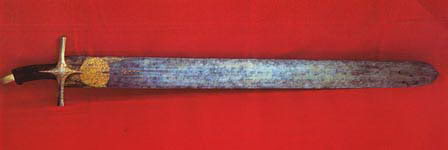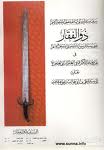| Author |
Message |
|
Ahmad Al-Tabari
Location: Toronto, ON, Canada Joined: 12 Sep 2010
Posts: 13
|
 Posted: Sun 12 Sep, 2010 10:51 pm Post subject: Early Islamic swords Posted: Sun 12 Sep, 2010 10:51 pm Post subject: Early Islamic swords |
 |
|
Hello Everyone
As an avid reader of David Nicolle's books about medieval Islamic arms and armour, I have noticed that he constantly states that the early Islamic/Arab sword was quite short and very similar to the Gladius. However, most of the swords that are attributed to Prophet Muhammad and his companions were clearly long swords.
I have two questions. My first question is, are these above mentioned swords (most of which are in Topkapi Museum) Sassanid imports or Yemeni blades?
My second question is, would these "long swords" have been reserved for the elite of Arabian society who could afford?
David Nicolle is a wonderful author with an ocean of knowledge about Islamic arms and armour, but unfortunately I have yet to learn his opinion about the Topkapi "long swords". And so any input would be greatly appreciated.
"My blow cut about four inches off the dagger blade and severed his forearm in two. The mark of the edge of the dagger was left on the edge of my sword. A craftman in our town, on seeing it, said: "I can remove this dent." But I said: "Leave it as it is. It is the best thing on my sword." The mark is there to this day." -Usamah Ibn Munqidh
|
|
  |
 |
|
Timo Nieminen
|
 Posted: Mon 13 Sep, 2010 4:14 am Post subject: Posted: Mon 13 Sep, 2010 4:14 am Post subject: |
 |
|
Al-Kindi ("On swords and their kinds") has "ancient" (i.e., best quality) swords as 3-4 fingers broad, and 3.5 to 4 spans in length for Yemeni swords, 3-4 fingers in breadth and 4-5 spans in length for Qala'i swords. For a 9" span, that makes for 30" to 36" to 45" blades, or 75cm, 90cm, 115cm. Al-Kindi (or at least the translation I read) doesn't say explicitly whether this is the length of the blade only or the total length. It appears to be blade only.
If these lengths are lengths of blades, then most of the 9 swords of Muhammad are about this length (al-Rasub is much longer). So, they could be Yemeni.
As "ancient" swords, these are the top quality, most expensive.
"In addition to being efficient, all pole arms were quite nice to look at." - Cherney Berg, A hideous history of weapons, Collier 1963.
|
|
   |
 |
|
Ahmad Al-Tabari
Location: Toronto, ON, Canada Joined: 12 Sep 2010
Posts: 13
|
 Posted: Mon 13 Sep, 2010 10:37 am Post subject: Early Islamic swords Posted: Mon 13 Sep, 2010 10:37 am Post subject: Early Islamic swords |
 |
|
| Timo Nieminen wrote: | Al-Kindi ("On swords and their kinds") has "ancient" (i.e., best quality) swords as 3-4 fingers broad, and 3.5 to 4 spans in length for Yemeni swords, 3-4 fingers in breadth and 4-5 spans in length for Qala'i swords. For a 9" span, that makes for 30" to 36" to 45" blades, or 75cm, 90cm, 115cm. Al-Kindi (or at least the translation I read) doesn't say explicitly whether this is the length of the blade only or the total length. It appears to be blade only.
If these lengths are lengths of blades, then most of the 9 swords of Muhammad are about this length (al-Rasub is much longer). So, they could be Yemeni.
As "ancient" swords, these are the top quality, most expensive. |
Thanks for your reply. Very useful info. I guess that means that only the elite of early Arabian society were able to afford these kinds of swords. The vast majourity probably had to use short swords quite similar to the gladius.
Do you know where I can find a copy of Al-kindi's book?
"My blow cut about four inches off the dagger blade and severed his forearm in two. The mark of the edge of the dagger was left on the edge of my sword. A craftman in our town, on seeing it, said: "I can remove this dent." But I said: "Leave it as it is. It is the best thing on my sword." The mark is there to this day." -Usamah Ibn Munqidh
|
|
  |
 |
|
Ahmad Al-Tabari
Location: Toronto, ON, Canada Joined: 12 Sep 2010
Posts: 13
|
 Posted: Mon 13 Sep, 2010 10:47 am Post subject: Early Islamic swords Posted: Mon 13 Sep, 2010 10:47 am Post subject: Early Islamic swords |
 |
|
Here are a few pictures of swords attributed to Prophet Muhammad and his companions. Most of the swords are in the Topkapi musuem.
http://www.sunna.info/souwar/img1042.htm
 Attachment: 1.41 KB Attachment: 1.41 KB

 Attachment: 10.53 KB Attachment: 10.53 KB

 Attachment: 11.77 KB Attachment: 11.77 KB

 Attachment: 3.08 KB Attachment: 3.08 KB

 Attachment: 3.41 KB Attachment: 3.41 KB

"My blow cut about four inches off the dagger blade and severed his forearm in two. The mark of the edge of the dagger was left on the edge of my sword. A craftman in our town, on seeing it, said: "I can remove this dent." But I said: "Leave it as it is. It is the best thing on my sword." The mark is there to this day." -Usamah Ibn Munqidh
|
|
  |
 |
|
Timo Nieminen
|
 Posted: Tue 14 Sep, 2010 2:14 pm Post subject: Re: Early Islamic swords Posted: Tue 14 Sep, 2010 2:14 pm Post subject: Re: Early Islamic swords |
 |
|
| Ahmad Al-Tabari wrote: | | Timo Nieminen wrote: |
As "ancient" swords, these are the top quality, most expensive. |
Thanks for your reply. Very useful info. I guess that means that only the elite of early Arabian society were able to afford these kinds of swords. The vast majourity probably had to use short swords quite similar to the gladius. |
There seems to be very large variation in prices. For swords of a particular weight (2.75 ratls = either 2.75 pounds or about 2.15 pounds, depending on the ratl), al-Kindi has prices:
Yemeni: 50-100 dinars
Qala'i: 10-15 dinars, or 5 dinars if there are forging flaws
(So al-Kindi describes the making of imitation Yemeni swords in Qala'a, to sell as Yemeni.)
Salmani swords are again cheaper (so are attempted to be sold as Qala'i); these are generally heavier, so not likely to be little short swords.
Kufan swords sell for 2-8 dinars, depending on size and quality, very light ones for 1 dinar.
Indigenous swords (i.e., cheap locally-made swords):
Khorasan: up to 30 dirhams
Basran: 2.5 dinars for good fake Yemeni sold as Yemeni, less than 4-6 dirhams for cheap, light, poorly forged ones.
Damascan: 15-20 dirhams
Egyptian: 10 dirhams
The cheap swords are not necessarily small, and can be larger (or at least heavier) than the expensive ones. I don't know the exchange rate between dirhams and dinars - 20 to 1? This makes the really cheap and nasty ones very cheap, about 1/5 - 1/10 the price of the cheapest "good" swords, and 1% or less of the price of the expensive ones.
| Ahmad Al-Tabari wrote: | | Do you know where I can find a copy of Al-kindi's book? |
This has a translation, commentary, and a facsimile of an original manuscript:
http://www.amazon.com/dp/0906094526/
"In addition to being efficient, all pole arms were quite nice to look at." - Cherney Berg, A hideous history of weapons, Collier 1963.
|
|
   |
 |
|
|
You cannot post new topics in this forum
You cannot reply to topics in this forum
You cannot edit your posts in this forum
You cannot delete your posts in this forum
You cannot vote in polls in this forum
You cannot attach files in this forum
You can download files in this forum
|
All contents © Copyright 2003-2025 myArmoury.com — All rights reserved
Discussion forums powered by phpBB © The phpBB Group
Switch to the Basic Low-bandwidth Version of the forum
|

